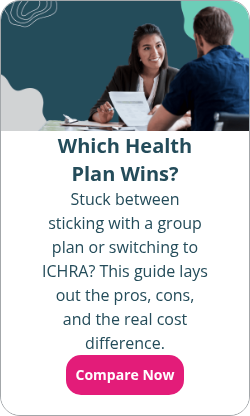How are health insurance premiums calculated?
By Elizabeth Walker on March 6, 2024 at 9:30 AM
If it’s your first time enrolling in a health insurance policy, you’re probably most eager to know how much your coverage will cost. While each type of insurance plan may vary in terms of copayments, coinsurance, and out-of-pocket expenses, no matter what plan type you choose, it will come with a premium to keep your policy active.
Knowing how insurance companies determine your premium is the first step to securing comprehensive and affordable health coverage for you and your family. In this guide, we’ll help you better understand what factors can influence your premium rate. We’ll also give you tips and tricks that can help you better control your premium costs to keep your policy within budget.
Takeaways from this blog post:
- Premiums are the dollar amount individuals pay their health insurance company to maintain continuous coverage. Insurers may offer reduced premiums for auto-payment, paperless billing, or paying the entire premium upfront for the whole plan period.
- Insurers determine premiums for Affordable Care Act-compliant plans by age, location, tobacco use, family size, and plan type. Insurers can’t use medical underwriting to calculate premiums or decline applicants with pre-existing health conditions.
- You can control your premium costs by enrolling in a high deductible health plan, applying for premium tax credits, or asking your employer to add a health reimbursement arrangement (HRA) or health stipend to your benefits package.
What is a health insurance premium?
A premium is the dollar amount an individual pays their health insurance company to maintain continuous and active health coverage. You’ll receive the covered services and items outlined in your policy by paying the premium and lower your overall out-of-pocket healthcare costs by sharing the costs of necessary products and services with your insurer.
Most policyholders pay their premiums monthly. But depending on your plan, your payments may be twice-monthly, quarterly, semi-annually, or annually.
As part of our 2024 report on the qualified small employer HRA (QSEHRA), we examined how often our customer’s employees paid their insurance premiums. We found that more than 87% of employees paid their premiums monthly, with 7% paying them fortnightly (every two weeks).
If you’re paying monthly, most insurers will require you to pay your first month’s premium before your coverage becomes effective. This is generally done during the annual open enrollment period if you enroll in an individual plan.
This can also happen at other times if you qualify for a special enrollment period and are enrolling in a new plan mid-year. Group health plans don’t have set open enrollment periods, as enrollment depends on when your employer offers coverage.
Most insurance companies allow policyholders to pay their premiums using various payment methods, like bank drafts, credit cards, debit cards, checks, and money orders. Depending on your insurer, they may provide you with a reduced premium if you opt for auto-payment, paperless billing, or paying your full payment upfront for the entire plan period.
How are health insurance premiums calculated?
In most cases, the creation of the Affordable Care Act (ACA) has standardized the process that insurance companies use to calculate a premium. But depending on where you received your health plan, the factors they use to determine your price may slightly differ.
In the sections below, we’ll go over three plan types and the aspects insurers consider under each to set your premium.
Traditional group health plans
With traditional group health insurance, employers purchase a medical plan from an insurance company or broker for their group of employees and eligible dependents. Oftentimes, the cost of the premium for this coverage type is split between the employer and the group participants. In most cases, the employer deducts the employee’s portion of the premium from their paycheck on a pre-tax basis.
How insurers determine the cost of group plan premiums varies depending on whether your employer has a large or small group health plan.
Key factors that can determine premium rates for large group plans are:
- Age: Premiums will typically be lower for individuals younger than 21 because younger people are less likely to need frequent healthcare. The most insurers can charge individuals older than 21 is three times the base premium rate for 21-year-olds. Because insurers can base group plan pricing on the entire group, the average age of the group can also affect premiums.
- The number of employees participating in the group plan: Since group health insurance plans spread risk across the entire group, the number of employees who participate in the plan can affect premium costs.
- Location: Insurers can charge higher premiums in regions, states, or ZIP codes with higher medical costs.
- Plan type: Certain types of plans, like a preferred provider organization (PPO) plan, will have higher premiums in exchange for a greater level of coverage than other plans, like a health maintenance organization (HMO) plan.
- Family size: A family plan generally costs more than a self-only health plan because of the coverage for dependents on the policy.
- Your company’s medical claim history: If your employer renews their policy, insurance companies can use their group’s claim history to adjust their premium rates.
- Sum insured: A sum insured is the most a health insurance provider will pay in a plan year. Employers estimate this amount and submit it to their insurer as a risk factor before determining a premium. The higher the sum insured, the higher the premium the group may receive.
- Industry: While not a primary deciding factor, the industry you work in can affect your premium costs. For example, a high health-risk industry, like construction, may have a higher coverage rate than a lower-risk industry, such as an IT company.
- Add-ons: Many group plans won’t cover pre-existing conditions, like diabetes, or ancillary benefits, like dental and vision, so employers can add coverage for these medical costs. Doing so can increase your premiums.
Insurers offering small group plans—such as those sold on the Small Business Health Options Program (SHOP) Marketplace1—must follow ACA guidelines. While small group plans are similar to large group plans, health insurers offering them can only vary their premiums based on age, family size, location, tobacco use, and plan type.
The ACA doesn’t allow insurers to base small group premiums on the group’s overall medical claims history, an individual’s medical history, or the group’s industry.
On-exchange health plans
An on-exchange health plan is one an individual buys on a public health exchange, such as a state-based marketplace or the federal Health Insurance Marketplace. Consumers can browse these marketplaces for an ACA-compliant, qualified health plan from various insurance companies.
Individual health insurance policies aren’t tied to employment. You can enroll in one during open enrollment or if you qualify for a special enrollment period.
Key factors that can determine premium rates for on-exchange health insurance plans are2:
- Age: Older individuals tend to have higher premiums because they use more healthcare services. But like group health insurance, premiums for older policyholders can’t be higher than three times the rate of a 21-year-old.
- Location: Individuals in areas with higher healthcare costs, insurer competition, state and local regulations, and cost of living may have higher premiums than those who don’t.
- Tobacco use: Also known as a tobacco surcharge, smokers can pay up to 50% more in premiums than non-smokers.
- Family status: Self-only health plans typically have lower premium rates than family plans that also cover spouses and dependents.
- Plan type: The federal government categorizes marketplace plans by metal levels—bronze, silver, gold, and platinum. Bronze and silver plans usually have lower monthly premiums but higher out-of-pocket costs. Gold and platinum plans tend to have the highest premiums but lower out-of-pocket costs.
Under the ACA, insurance companies can no longer use medical underwriting in premium calculations. They must also cover pre-existing medical conditions without charging a higher rate and charge men and women the same premium for the same plan.
All plans sold on public exchanges must also cover essential health benefits, such as preventive care, hospitalization, and ambulatory health services. However, some insurance companies may include extra benefits plans that can raise your premium. So, it’s essential to compare plans carefully when shopping for health insurance to ensure you’re purchasing an affordable policy that offers the coverage you need.
Off-exchange health plans
If you purchase an individual health plan directly from a health insurance company or broker, that’s called buying an off-exchange plan on a private health exchange. While public exchanges only offer ACA-compliant plans, private exchanges can offer ACA-compliant and other health plans, giving you more options to choose from.
Insurers and brokers selling off-exchange ACA-compliant plans can only calculate premiums by age, location, tobacco use, family status, and plan type—like public exchanges. This also means these plans must have the same premium as those sold on public exchanges, and they can’t use medical underwriting or decline or charge you more for pre-existing conditions.
However, private insurers also sell supplemental health plans like disability coverage, catastrophic plans, and dental or vision policies. Supplemental plans are typically exempt from many ACA requirements, meaning insurers can use other criteria to determine your premium. Therefore, you should check what factors your insurer may use before applying.
How you can control your premium costs
In some cases, your plan’s premium may be higher than you expected. In that case, you have a few options that can help you lower or better control your premium costs.
High deductible health plans (HDHPs)
Your first option is to select a high deductible health plan (HDHP). As the name suggests, an HDHP is a health plan with a high deductible you must meet before your insurer begins to cover qualified medical expenses. To offset the higher deductible, HDHPs tend to have lower monthly premiums than other health plans.
You can shop for an HDHP on a public or private health exchange or enroll in one through your employer if they offer this plan type as one of their group health insurance options. They’re particularly effective if you have a good health status and only need routine care or coverage in a medical emergency.
Premium tax credits
Federal cost-sharing reductions or subsidies, like premium tax credits, are also available for lower-income individuals to reduce their health plan premiums. You can receive your premium tax credits on your income tax return at the end of the year or get advance monthly payments to help pay for your premiums throughout the year.
Eligibility depends on your actual income level in relation to federal poverty guidelines, which the federal government adjusts annually.
However, the only individuals who can receive premium tax credits are those who purchase a plan on a public exchange, like a state-based marketplace or the federal marketplace. So, while you can still buy an ACA-compliant plan off-exchange, you won’t be eligible for a subsidy, which may make your premiums more expensive if you’re eligible for premium tax credits.
Health reimbursement arrangements (HRAs)
Your next option is to check your company’s benefits package. If your employer offers you a health reimbursement arrangement (HRA), you can receive tax-free reimbursements on your health insurance premiums and other qualified out-of-pocket medical expenses.
With an HRA, your employer gives you a set monthly allowance, which you can spend on your premiums and healthcare costs. Once you make an approved purchase, your employer reimburses you tax-free up to your allowance amount.
You can only receive premium reimbursements with a qualified small employer HRA (QSHERA) or an individual coverage HRA (ICHRA) if you have a qualifying form of individual health coverage. Those with an integrated HRA can receive reimbursements for other out-of-pocket expenses but not health insurance premiums. Therefore, it’s important to confirm the type of health insurance policy and HRA you have before getting started.
Additionally, you can coordinate your premium tax credits with a QSEHRA. You may have to reduce your tax credit by your allowance amount or opt out of your credits entirely to participate in the HRA.
Health stipends
Lastly, you can find out if your employer offers a health stipend. With this stipend, your employer offers you a set amount of money to pay for health insurance premiums and other out-of-pocket medical expenses. Because stipends are less regulated than HRA and other formal benefits, the IRS considers them regular income, and you must pay income taxes on the amount you receive.
But the great thing about health stipends is that they’re flexible. You can use your stipend money to help you pay for whatever medical expenses you choose. You can also take full advantage of the stipend in addition to traditional employer-sponsored coverage, individual plans, or an HRA.
Better yet, eligible employees can collect their full premium tax credit and participate in their stipend benefit without any penalties.
Conclusion
Having health insurance is essential for maintaining a healthy and happy family, especially with rising medical care costs. But before you sign up for health insurance coverage—whether through your employer, a public exchange, or a private exchange—you must know what factors your insurers will consider when they set your premium to avoid surprises.
While you might be unable to alter every factor they consider, you can try changing a lifestyle habit or choosing a different plan type to save on premium costs. Additionally, it’s always beneficial to find out if you’re eligible for premium tax credits or participate in your employer’s HRA or health stipend to make your health insurance even more affordable.
1. https://www.healthcare.gov/small-businesses/choose-and-enroll/shop-marketplace-overview/
Check out more resources
See these related articles

Group coverage vs. individual health insurance cost
In this article, we’ll compare group health and individual health insurance costs, and discuss a budget-friendly option for even more affordable insurance.

What is actuarial value?
Learn what actuarial value is and how it measures the percentage of healthcare costs a plan covers. Understand its role in health insurance choices.

What is a health insurance premium?
A health insurance premium is the amount of money you pay to your insurance provider for your health coverage. Learn more about health insurance premiums here.



